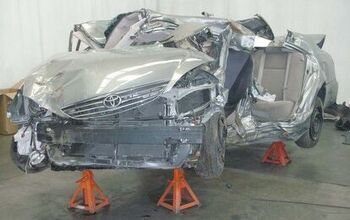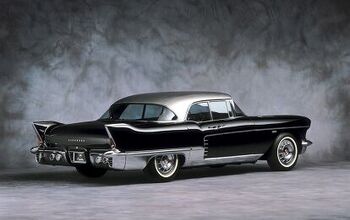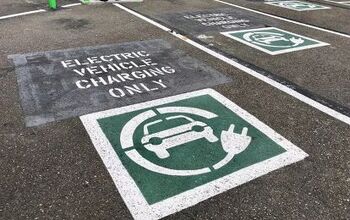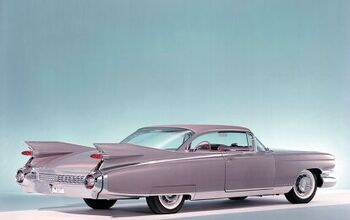Toyota Unintended Acceleration Experienced First Hand!

Call it the ultimate of ironies. Yesterday afternoon I headed to the Toyota dealer in my 2005 Toyota Scion xB for the purpose of shooting photographs of various Toyota gas pedals to see why certain models seemed to have a higher rate of UA complaints to the NHTSA. In search of some intended acceleration, I headed up the up-hill I-105 connector on-ramp at Washington Street at full throttle. As I lifted my foot off the accelerator pedal, it stayed wide open…
My first thought was to call Stephanie on the cell phone to hear her voice one more time Since my car is a stick shift, that happened at the same moment my foot also pushed in the clutch. The engine quickly revved to redline, and bounced off the rev limiter. I instantly gave the gas pedal a quick sharp jab, and it fell back to idle. The whole incident lasted between one to two seconds. I shifted into third, and was on my way.
What happened? I’m not sure, but here’s what didn’t happen: it wasn’t a “sticky e-pedal” since the Scion has an old fashioned throttle cable. It wasn’t floor mat entrapment, but it sure could have been before I cut the whole front section of my all-weather rubber mat off. It has a huge lip around the edge, enough to contain a small lake of melted snow or mud. But I had serious problems with it getting in the way of my pedals when I first bought the car (used) three years ago.
The mat constantly interfered with both the gas and clutch pedal. I could deal with the gas pedal, by quickly shoving the mat to the left with my foot, and it didn’t really ever “jam” the pedal wide open. It tended to just get in front of it, and slow its return or just generally get in the way. But the mat kept the clutch pedal from its full travel, which may have contributed to harder shifting. I quickly got tired of the mess and cut the whole front section of the mat off. I don’t know if these are Scion/Toyota mats, or aftermarket. The have no retaining mechanism or any identifying mark, so I suspect that they’re aftermarket.
I had installed an aftermarket cruise control (myself), but that was turned off. [Update:I’m 99% certain it wasn’t the CC. I installed it myself, and understand its mechanical relationship to the throttle. It’s designed well just to avoid this type of problem. It has a long open slot, in which a pin from the throttle rides in, so that if the CC is not engaged, it can’t hold back the throttle; a good fail-safe design. I’ve checked it out again this morning, and all of the CC and throttle linkage are working perfectly and freely, and I can’t really see how that could be it.]
The throttle pedal, cable and throttle assembly itself all seem to be fine, in checking their action and their return springs. It certainly wasn’t a case of pedal confusion. The first signs of a deteriorating throttle cable? A sticky throttle mechanism, which was implicated in Toyotas (and other cars) back in the late eighties and early nineties, due to carbon build up? Changes in gasoline formulations supposedly ended that. A one second demonic possession? Shit happens?

More by Paul Niedermeyer
Latest Car Reviews
Read moreLatest Product Reviews
Read moreRecent Comments
- AZFelix What could possibly go wrong with putting your life in the robotic hands of precision crafted and expertly programmed machinery?
- Orange260z I'm facing the "tire aging out" issue as well - the Conti ECS on my 911 have 2017 date codes but have lots (likely >70%) tread remaining. The tires have spent quite little time in the sun, as the car has become a garage queen and has likely had ~10K kms put on in the last 5 years. I did notice that they were getting harder last year, as the car pushes more in corners and the back end breaks loose under heavy acceleration. I'll have to do a careful inspection for cracks when I get the car out for the summer in the coming weeks.
- VoGhost Interesting comments. Back in reality, AV is already here, and the experience to date has been that AV is far safer than most drivers. But I guess your "news" didn't tell you that, for some reason.
- Doc423 Come try to take it, Pal. Environmental Whacko.
- 28-Cars-Later Mazda despite attractive styling has resale issues - 'Yota is always the answer.


































Comments
Join the conversation
I'm inclined to second Detroit-X's somewhat foggy comments: check and then spray-clean the throttle body and plate. A buildup of fuel gum on the throttle plate, body, and shaft can at certain temperatures be extremely tacky. In the old days this gum used to prevent automatic chokes from working correctly, but the throttle plate on a carburetor or TBI system is wet; always being washed down by fresh fuel. The throttle plate on a port fuel injection system is dry, so there's nothing to wash down the gradual gum buildup that forms from fuel evaporation after shutdown. There's not much fuel in the intake tract after shutdown, but there's some, and little by little... Anyhow, check it out. Oh, and what make and model of CC did you install? I'm after one myself.
Paul, always enjoy reading your articles. I've had a similar experience with a cable throttle, manual transmission car and thought I might offer one more suggestion. With mine, it was neither the cable, the pedal, nor anything external to the throttle body at fault. I too could usually fix the issue by jabbing the throttle. When I finally had reached my wit's end and was replacing the TB, I removed the throttle position sensor to swap it over to the spare TB. I found small chunks of aluminum jamming the dog on the throttle pivot inside the sensor housing, because a bolt 3mm too long had been installed to affix the TB bracket and pushed the material at the back of the blind hole into the housing. It was even an OE bolt, just used in the wrong hole by the previous owner. This also coincidentally fixed a rough idle I had previously considered unrelated, because they were jamming the sensor partially open as well. Just something to consider; even in the most well-thought-out (factory) systems, a few millimeters can make all the difference.